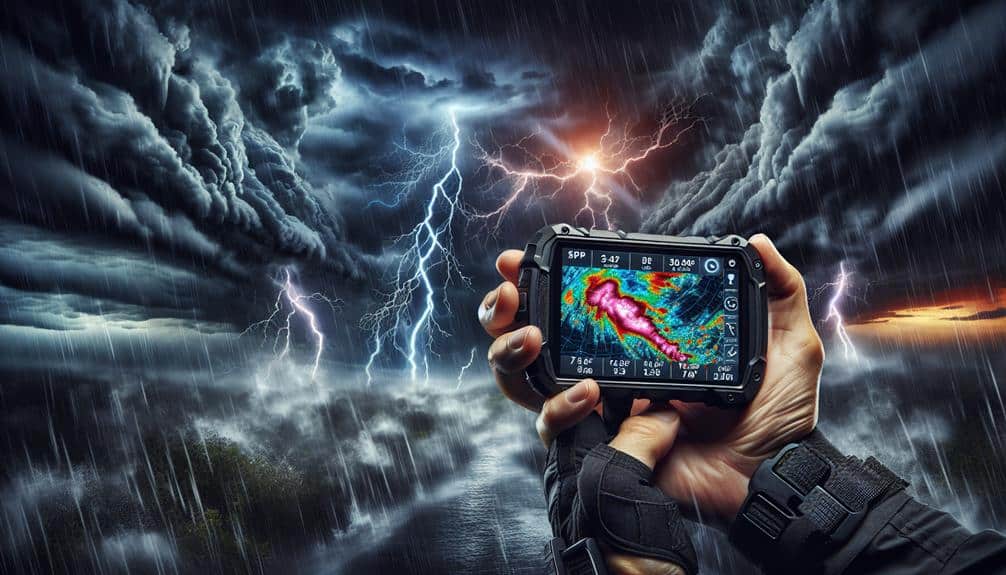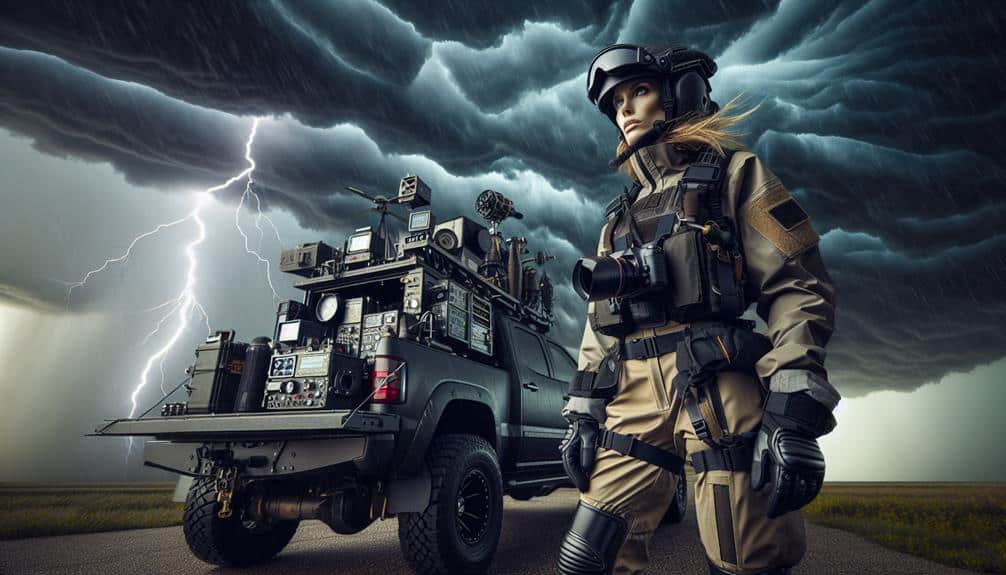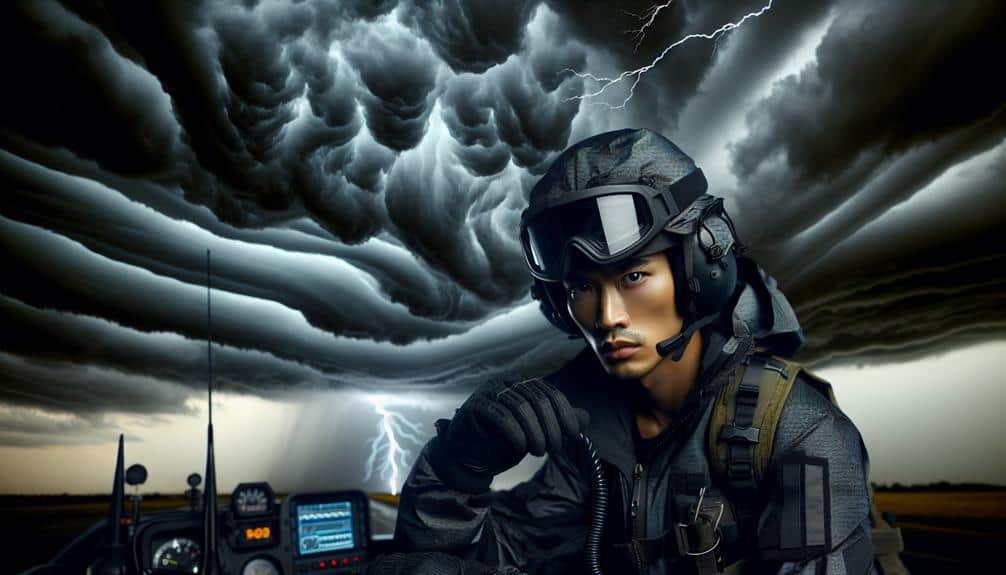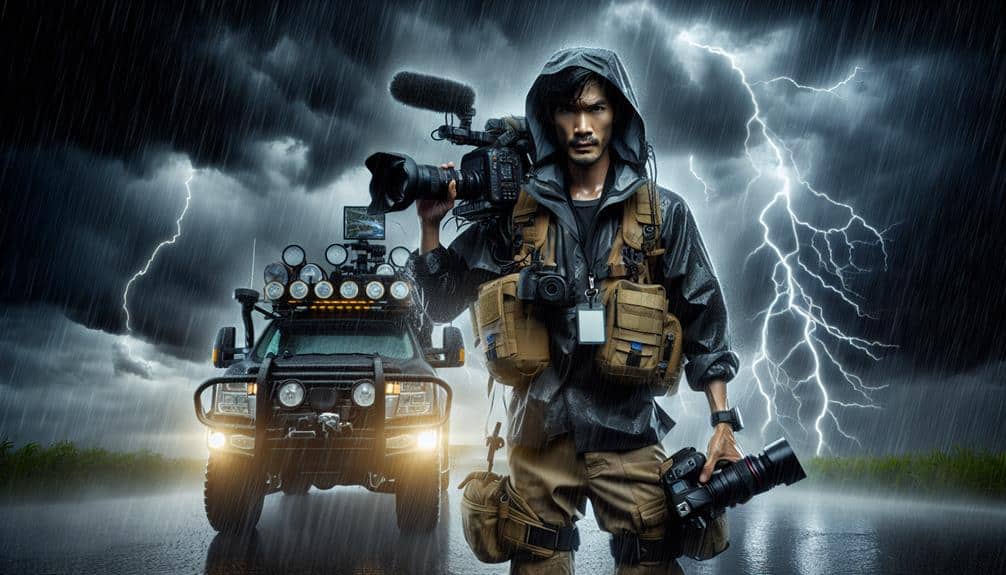When storm chasing, we depend on several excellent communication devices to guarantee safety and efficiency. Satellite phones provide reliable connectivity and GPS tracking even in remote areas, while two-way radios facilitate direct team communication despite harsh conditions. Mobile hotspots offer essential real-time data through strong network speeds and international roaming options. Weather radios, such as the Midland WR120B, deliver real-time NOAA alerts and durable performance. Moreover, GPS devices guarantee accurate location tracking, and emergency beacons offer vital SOS capabilities. Each device plays a significant role in our operations, enhancing both safety and data accuracy essential for storm chasing.
Key Points
- Satellite phones provide reliable communication, GPS tracking, and SOS functions in remote areas.
- Two-way radios offer immediate, durable communication with weather resistance and extended battery life.
- Mobile hotspots ensure network speeds for real-time data with high data allowances and international roaming options.
- Weather radios deliver strong signals and NOAA alerts with long battery life and portability.
Satellite Phones
Satellite phones provide storm chasers with reliable communication in remote areas where traditional cell service is unavailable. In our line of work, we face unpredictable weather conditions and terrain that can greatly impact signal strength. A satellite phone ensures that we maintain a strong connection even in the most isolated locations. This capability is essential when we need to relay real-time data or receive critical updates.
Satellite phones leverage a network of satellites orbiting the Earth, which allows them to deliver consistent communication capabilities. We can make voice calls, send text messages, and even transmit data without the reliance on terrestrial cell towers. This independence from ground-based infrastructure significantly improves our operational flexibility.
Moreover, the importance of maintaining emergency contacts can't be overstated. In life-threatening situations, having a reliable means of communication can make the difference between safety and peril. Satellite phones are equipped with features like GPS tracking and SOS functions, providing additional layers of security. These devices enable us to quickly reach emergency services or notify team members of sudden changes in weather conditions and potential hazards.
Two-Way Radios
While satellite phones offer extensive coverage, two-way radios provide storm chasers with immediate and direct communication within a localized team. These radios are indispensable for maintaining contact when we're moving through volatile weather conditions.
When selecting the best two-way radios, we need to take into account several important factors:
- Signal strength and range: A high signal strength guarantees that our messages are transmitted clearly, even in remote areas. We should choose radios that provide a range of at least 20 miles to cover diverse terrains and maintain reliable communication.
- Durability: Given the harsh environments we often encounter, our radios must withstand physical stress. Models with sturdy construction are essential to withstand falls, impacts, and other potential damages during storm chasing.
- Weather resistance: Radios with advanced weatherproofing can resist rain, wind, and dust. This feature is vital since exposure to the elements is unavoidable. Look for devices with at least an IP67 rating for best protection.
- Battery life: Extended battery life is essential for long chases. Radios with rechargeable batteries and energy-efficient designs ensure we stay connected without frequent recharges.
Mobile Hotspots
Let's evaluate mobile hotspots, focusing on:
- Data plan options
- Coverage and reliability
We need to guarantee our devices provide consistent internet access in remote areas where storm activity is prevalent.
Data Plan Options
Among the myriad choices available for mobile hotspots, we must evaluate the data plan options that offer the most reliable connectivity and cost-efficiency for storm chasers. Evaluating these plans involves scrutinizing network speeds and international roaming capabilities, both essential for ensuring seamless data access during pivotal moments.
- Network Speeds: High-speed networks such as 5G are vital for storm chasers who rely on real-time data. Plans that offer substantial bandwidth and low latency help us upload and download information swiftly, providing an advantage in fast-changing weather conditions.
- Data Caps and Throttling: Many data plans impose limits on data usage, after which they may throttle speeds. We must consider plans with high data caps or even unlimited data to avoid interruptions during significant operations.
- Cost-Effectiveness: Balancing cost and performance is key. Plans offering higher data allowances at reasonable prices are preferable, ensuring we get maximum value without overspending.
- International Roaming: For storm chasers who operate across borders, international roaming options are indispensable. Plans that offer extensive international data coverage prevent us from being stranded without connectivity when chasing storms in different countries.
Coverage and Reliability
To ensure our mobile hotspots offer consistent and reliable connectivity, we must carefully evaluate their coverage and reliability across different regions. Examining signal strength is crucial, as it directly impacts our ability to receive emergency alerts and maintain uninterrupted communication during storm chasing. Mobile hotspots with strong signal strength guarantee we stay connected even in remote areas, where traditional networks might struggle.
In addition, assessing the communication range of these devices is essential. A wider communication range allows us to maintain contact over larger distances, which is particularly important when tracking storms that cover vast geographic areas. By selecting mobile hotspots with expansive coverage, we reduce the risk of losing connectivity at critical moments.
Network backup is another significant factor to take into account. Reliable mobile hotspots should support multiple network types, enabling automatic switching between networks to maintain a stable connection. This redundancy is crucial for ensuring that we receive timely emergency alerts and can communicate effectively, regardless of the primary network's condition.
Battery Life Considerations
Often overlooked but vitally important, the battery life of our mobile hotspots directly impacts our operational efficiency and safety during storm chasing. Reliable power sources are essential for maintaining communication and accessing real-time data in extreme weather conditions.
Here, we'll explore key considerations to make certain our mobile hotspots never leave us disconnected.
- Battery Capacity: Prioritize mobile hotspots with high-capacity batteries. Look for models that offer a minimum of 10 hours of continuous use. Battery life is vital during prolonged chases where recharging opportunities are limited.
- Power Banks: Investing in high-capacity power banks is essential. Opt for power banks with fast-charging capabilities and multiple ports, enabling us to charge multiple devices simultaneously. Field testing shows that power banks rated at 20,000mAh or higher perform best in extreme weather.
- Solar Chargers: Solar chargers provide a sustainable power solution in the field. Ensure they're rated for rugged use and can efficiently convert sunlight even on overcast days. Models with foldable panels are particularly convenient for easy storage.
- Energy-Saving Features: Choose mobile hotspots with built-in energy-saving features such as automatic shutdown in idle mode. These features greatly extend battery life, especially when every minute of connectivity is crucial.
Weather Radios
When discussing weather radios, we should first consider their essential features, such as NOAA alerts and battery life.
We'll then review some of the best models available based on user reviews and technical specifications.
Essential Features Overview
Weather radios are indispensable for storm chasers, offering real-time alerts and updates that can make the difference between safety and disaster. These devices are designed to provide critical information, but not all weather radios are created equal. To ensure we've the best tool at our disposal, there are several essential features to consider.
First and foremost, signal strength is pivotal. A weather radio must be able to receive strong signals even in remote locations. This guarantees we get timely alerts, regardless of how far we're from urban centers.
Next, durability ratings are essential. Storm chasing often involves harsh weather conditions. A weather radio with high durability ratings will withstand rain, wind, and impact, ensuring it remains functional when we need it most.
Here are the four essential features to look for:
- Signal Strength: Ability to receive clear signals in remote areas.
- Durability Ratings: High resistance to weather and physical impact.
- Battery Life: Long-lasting power to guarantee continuous operation.
- Portability: Compact and lightweight design for easy transport.
Best Models Available
Among the top weather radios available, we find models that excel in signal strength, durability, battery life, and portability, making them indispensable tools for storm chasers.
The Midland WR120B/WR120EZ stands out with its robust signal strength, ensuring that we receive timely weather alerts even in remote areas. Its SAME (Specific Area Message Encoding) technology allows for precise alert targeting, enhancing our situational awareness.
For those prioritizing durability, the Eton FRX5-BT offers excellent durability features. Its rugged design can withstand harsh weather conditions, and it's equipped with a hand crank and solar panel for extended battery life, ensuring we stay powered during prolonged chases.
The Sangean MMR-88 is another top contender, combining high signal strength with impressive durability features. It includes a built-in LED flashlight, offering multifunctionality essential for storm chasers. Additionally, it boasts a rechargeable battery with multiple charging options, including solar and hand crank, ensuring we remain connected when it matters most.
Usage Tips and Tricks
Maximizing the usefulness of these top-tier weather radios necessitates a thorough understanding of their features and best usage techniques. By delving into the specifics, we can guarantee our communication strategies are robust and our emergency protocols are sound.
1. Utilize Signal Boosters:
To enhance the range and clarity of our weather radios, incorporating signal boosters is vital. This helps us receive weather alerts promptly, even in remote areas with weak signals.
2. Set Multiple Weather Alerts:
Customizing the alerts to notify us about various weather conditions is important. By configuring our devices to monitor multiple types of weather alerts, we can stay informed and make timely decisions.
3. Prioritize Battery Management:
Ensuring our weather radios are always operational requires diligent battery management. Using rechargeable batteries and carrying spares can prevent unexpected power failures, especially during extended chases.
4. Integrate with Other Communication Devices:
Merging our weather radios with other communication devices, like smartphones or satellite phones, enhances our overall communication strategies. This integration provides a complete network for receiving and disseminating critical information.
GPS Devices

GPS devices are essential for storm chasers, providing real-time location tracking and precise guidance in rapidly changing weather conditions. In our field, reliable signal strength is crucial. High-quality GPS units guarantee strong connectivity even in remote or obstructed areas, allowing us to maintain accurate positioning data. This capability is critical when moving through storm-prone regions where terrain and visibility can be unpredictable.
A key feature to take into account is the waterproof design of the GPS device. Storm chasing often involves exposure to harsh weather conditions, including heavy rain and flooding. A waterproof GPS unit protects our investment and ensures the device remains functional regardless of the weather. This resilience isn't just a convenience; it's a necessity for maintaining operational integrity during critical moments.
Furthermore, modern GPS devices often come with advanced mapping software and real-time updates. These features facilitate efficient route planning and hazard avoidance, enhancing our overall safety and effectiveness in the field.
Emergency Beacons
Emergency beacons are indispensable tools for storm chasers, providing a critical lifeline when conventional communication channels fail during extreme weather events. These devices guarantee that we can send distress signals and receive help in the most dire situations.
To maximize our safety, we should consider several key features when selecting an emergency beacon.
- Signal Strength: The effectiveness of an emergency beacon largely depends on its signal potency. High signal potency guarantees that our distress signals penetrate through dense cloud cover and other atmospheric disturbances, reaching rescue teams promptly.
- SOS Capabilities: Modern beacons come with advanced SOS functions, which include automated distress signals and GPS location tracking. These features facilitate faster response times from emergency services, thereby enhancing our chances of being rescued swiftly.
- Battery Life: A long-lasting battery is essential, as extreme weather can prolong rescue operations. We should opt for beacons with extended battery longevity to secure continuous operation until help arrives.
- Durability: Given the harsh conditions storm chasers often face, our emergency beacons must be rugged and water-resistant. Durable construction guarantees that the device functions correctly even after exposure to extreme elements.
Frequently Asked Questions
How Do I Charge My Devices During Long Storm Chasing Trips?
To charge our devices during long storm chasing trips, we use solar charging panels and portable generators. These solutions provide reliable power, ensuring our equipment stays operational without depending on fixed power sources, giving us the freedom we desire.
Are There Any Apps Specifically Designed for Storm Chasers?
Yes, there are apps specifically designed for storm chasers. We use storm tracking apps like RadarScope and emergency alerts apps like NOAA Weather Radar to stay informed and safe during our storm chasing adventures.
What Kind of Protective Cases Are Best for Harsh Weather Conditions?
We recommend impact resistant cases for their durability and superior weatherproofing options. These cases offer excellent shock resistance, ensuring our devices remain functional and protected in harsh weather conditions, providing us the freedom to chase storms confidently.
How Can I Ensure My Communication Devices Are Waterproof?
Think Poseidon's domain. We can guarantee our communication devices are waterproof by using waterproof accessories and performing proper maintenance. Regularly check seals and cases for integrity to keep devices operational in any weather conditions.
Which Power Banks Are Recommended for Storm Chasers?
For storm chasers, we recommend power banks with solar chargers and emergency radios. Portable generators and satellite phones are also essential, ensuring continuous power and reliable communication even in remote locations. Freedom depends on staying connected and prepared.


